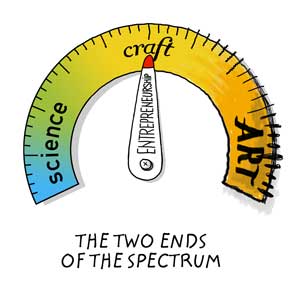Author: Bill Aulet
In my 20-plus years as an entrepreneur and seven years as an entrepreneurship educator, I have explored whether starting successful companies should be thought of as a science or an art. If entrepreneurship is a science, then I could easily teach my students that if they perform actions X and Y, they will get a result of Z. If it is an art, then it can be described no more precisely than as an ambiguous creative process that only a chosen few can pursue as a profitable career.
While I find many elements of entrepreneurship that draw from empirical processes, I also find many others that require creativity. In looking for a mental model that encompasses both requirements in a cohesive model for how to most successfully approach the startup process, I started thinking about potters. These skilled individuals imbue artistry into each pot they throw, but if they don’t have knowledge of the fundamentals of how to mold clay into finished objects, they won’t succeed in their goal. Pottery is neither science nor art. Instead, it’s a craft — a process that draws from both.
There are a few key characteristics of pottery that firmly plants it into the realm of craft, rather than being either an art or science:
It’s accessible. Almost anyone can make a pot from clay. It is not something available only to an elite few who are gifted with extraordinary talent.
It’s learnable. Pottery consists of a number of fundamental skills that aren’t obvious without being taught the particulars of the discipline, but these skills can be taught and learned. Luck alone does not make a potter.
It values unique products. When pottery is done well, it is beautiful and unique. The goal of many pottery craftspeople is not to mass-produce the same item that they or others have created before, but to make something new and valued.
It’s built on fundamental concepts. When a potter is learning how to throw clay on a pottery wheel, there are basic principles such as how to use your fingers and thumbs to mold differently sized grooves and how to perfectly calibrate your foot pedals. While knowing these won’t guarantee success, they can dramatically improve a potter’s odds of understanding more complex concepts later on.
It’s best learned through apprenticeship. For many craftspeople, a crucial part of the education process is apprenticeship. Understanding the full body of knowledge about the craft involves not only using the pottery wheel but other specific skills such as kneading, wedging, and using a kiln. These can be explained via lecture without hands-on practice, but are best learned when combined with apprenticeship-type training.
Read the rest of the article at Sloan Management Review



Follow